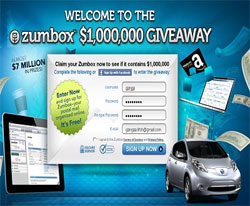
The push-pull problem with America's digital postal mail
Major mailers in the United States are seeking to move from physical to digital communications a lot more quickly than expected – but consumers still appear to be more comfortable with their bills and statements arriving through the mail. Digital postal mail provider Zumbox revealed yesterday that it has convened an advisory board comprising representatives from major mailing companies and mailflow technology specialists including DST Output, 3i Infotech and Ricoh Production Print Solutions.
The board’s first meeting, this summer, heard that awareness of the benefits of moving to digital mail was now “widespread” among transactional mailers, and that it was now clearer to them that the benefits extend beyond merely cost savings associated with paper suppression.
“There is no one out there who isn’t aware the market is going digital, and it is going digital much more rapidly than anyone expected it would,” said Zumbox chief executive John Payne, commenting on the view from the new advisory board.
Payne said that before the 2008 financial crisis, transactional mailers had encouraged customers to engage through digital means, but that post-downturn there was now more of an attitude that “We’re spending way too much of our operating dollar on print communications when it isn’t necessarily doing any good.”
Cost-cutting mailers have been looking into “aggressively” pushing customers towards the less costly digital channel according to industry observers – even flipping the default for new accounts to receive communications digitally and actually require consumers to opt in to receiving physical mail versions.
However, in its first thrice-yearly meeting the Zumbox advisory board also heard the warning that although mail volumes have been declining rapidly in the US, 71% of US consumers still feel more secure holding an official paper copy of their bills and statements, and that to push them forcibly into digital channels could risk losing those customers altogether.
Industry analyst Matt Swain, associate director at Massachusetts-based market research firm Infotrends, said: “Organisations sending transactional mail to their customers are very aggressively attacking the paper bills and statements, looking to make that transition from paper billing to electronic.
“But we do not see it as being at that cliff where change is happening so rapidly that it’s going to completely disrupt current technologies,” he added.
Swain presented the findings of his research on the issue to the Zumbox advisory board in June, and said that despite the current marketing effort pushing paperless channels, it was still clear that a large part of the US population wants only to deal with bills and statements through the mail.
“Some customers really don’t want to make that transition [to digital mail],” Swain said, detailing his recommendations to the Zumbox advisors to Post&Parcel yesterday. “You need to make sure that you are providing a superior customer user experience because if you’re just looking at cost reduction and not at the user experience, you’re also going to have a user reduction if they are not happy with the service they are getting.”
Benefits
California-based Zumbox offers a digital version of every address in America – with 120m digital mailboxes sitting ready for consumers to claim. Once claimed, Zumbox steers mail from its mailing partners into those mailboxes to replace the physical mail bills and statements.
John Payne, Zumbox CEO said his company’s new advisory board suggested that major mailers in America were now recognising that the cost savings from paper suppression in switching to digital channels was just the “tip of the iceberg” in terms of the benefits from digital postal mail.
He said that mailers were finding that digital documents could much more easily steer customers requiring support towards less costly and more effective support options than the conventional telephone call that is generally the first line of response in a paper bill or statement. For example, the use of online chat systems can prove 50-60% less costly to run, while enjoying the highest levels of consumer satisfaction, said Payne.
Customer experience is further improved, said the Zumbox CEO, with the comparitive ease digital mail has in steering consumers to the most easy – and cheap – payment options, for example direct bank transfer processes. On top of this, digital reminders can be sent to prompt users to pay bills on time.
Another major benefit of digital postal mail for mailers is in the ease of cross-promotion – using the digital mail platform as an extension of their online advertising efforts.
Payne said: “For years people have been working on transpromo and getting marketing integrated into paper statements, but when you integrate in a digital postal mail document such as ours, you can actually use the campaign management tools that large financial institutions and large consumer mailers are already using to interact directly with their customers.”
Consumers

Zumbox has been running a contest to attract consumers, which includes a $1m top prize
Zumbox has been running publicity campaigns over the summer, including a competition that has prizes waiting in 7,500 of its 120m digital mailboxes waiting to be claimed by American householders – including a million-dollar top prize and 20 Nissan Leaf electric cars.
Payne said his company has also been aligning itself with partner organisations, including municipal authorities like the City of Minneapolis, Minnesota, to encourage consumers to switch to digital. Zumbox fits in with partner organisations’ cost-reduction and sustainability goals, he explained.
Although the Zumbox CEO would not reveal how many consumers have signed up for their digital mailboxes so far – that number is set for an announcement later this year, when an expected milestone has been achieved – he said Zumbox was ahead of target.
“Consumers recognised the problem we solved very quickly,” Payne said. “We’ve been very happy, we’ve surpassed our goals each month by a considerable amount. We’re very happy with how many consumers we’ve signed up.”
Swain said consumers in North America – Canada a little more so than the United States – are expecting to steadily move from the physical to digital channel, but those expectations are “a little more conservative” than those of major transactional mailers.
In his company’s study of North American digital mail, forecasts were that the 11% of consumers in the US receiving bills and statements online-only would likely rise only to about 22% by 2014.
The issue is not about the availability of internet or broadband access, he said, since the US has very high levels of internet penetration. It’s not necessarily that people have issues with paying bills through the internet, Swain added, since many Americans like to receive paper bills then go online to pay them.
“You do have people that just really like the physical reminder to pay, or that backup or archive that just goes in that box in their closet,” he said.
There are concerns about the security of internet-based transactions, but Swain also pointed out that despite the growing trend of online account consolidators and digital in-boxes like Zumbox, Doxo, Heart Corp’s Manilla and Pitney Bowes’ Volly, consumers do not yet see the digital channel as easy enough to replace the physical channel.
Swain said based on the Infotrends research, the most effective target for mailers at the moment was to persuade those customers currently using both online bill presentment and physical mail at the same time to switch to digital-only.
For other consumers, he said there would need to be a clearer reason for people to change.
“We’re creatures of habit – it’s going to take a strong incentive to make us change,” Swain said of his fellow Americans. “The incentive could be greater convenience, it could be getting back more time in our day, or it could be financial – perhaps something like Zumbox’s $1m giveaway.”









